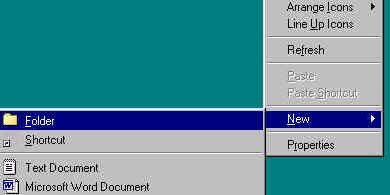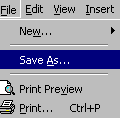Files and Folders
![]()
Almost all information in a computer must be stored in a file. A file is a collection of data stored under a name. A folder contains multiple documents or files.
![]() Creating
and naming folders
Creating
and naming folders
There
are two different ways to create folders:
![]() Create a folder by Right-Clicking:
Create a folder by Right-Clicking:
![]() Right-click the empty area on the desktop,
folder window, or common dialog box.
Right-click the empty area on the desktop,
folder window, or common dialog box.
![]() Point to New and then click at Folder.
Point to New and then click at Folder.
![]() A new folder icon will appear with a
temporary filename. You need to type a new folder name and then
press enter to
accept the change.
A new folder icon will appear with a
temporary filename. You need to type a new folder name and then
press enter to
accept the change.

![]() Create folder by using Menu:
Create folder by using Menu:
![]() Click File menu then point to New and click at Folder.
Click File menu then point to New and click at Folder.
![]() A new folder icon will appear with a temporary filename which already has been
highlighted. You need to type new folder name and then press enter to accept the
change.
A new folder icon will appear with a temporary filename which already has been
highlighted. You need to type new folder name and then press enter to accept the
change.
![]() Click here to see an illustration.
Click here to see an illustration.
![]() Practice
creating a new folder and naming it.
Practice
creating a new folder and naming it.
![]() Renaming
folders and files
Renaming
folders and files
You can
rename folders and files anywhere, such as, on the desktop,
in a folder, and in a common dialog box. Following
is a common way to rename folders or files:
![]() Right-click
on a folder or file to rename it.
Right-click
on a folder or file to rename it.
![]() Click Rename on the pop-up menu that
appears.
Click Rename on the pop-up menu that
appears.
![]() Highlight the name and type your desired name; then press enter.
Highlight the name and type your desired name; then press enter.
![]() Practice
renaming folders and files.
Practice
renaming folders and files.
![]() Moving
one folder inside another one
Moving
one folder inside another one
You can move one
folder inside another one by choosing from the following:
![]() Move one folder inside another one by using the Menu.
Move one folder inside another one by using the Menu.
![]() Select folders you want to move by pointing and left-clicking to item.
Select folders you want to move by pointing and left-clicking to item.
![]() Click Edit menu and then click Cut. You will see that the cut file’s
icon will be dimmed.
Click Edit menu and then click Cut. You will see that the cut file’s
icon will be dimmed.
![]() Close the first folder and then you open the destination folder window.
Click Edit menu and after that click paste.
Close the first folder and then you open the destination folder window.
Click Edit menu and after that click paste.
![]() Move one folder inside another one by dragging
Move one folder inside another one by dragging
![]() Arrange the desktop so that the source folder and destination folder
windows (or icons) are in view.
Arrange the desktop so that the source folder and destination folder
windows (or icons) are in view.
![]() Select folder to copy and after that left click and hold as you move it (drag)
to select folder onto destination folder window.
Select folder to copy and after that left click and hold as you move it (drag)
to select folder onto destination folder window.
![]() Practice
moving one folder inside another one.
Practice
moving one folder inside another one.
![]() Moving
(sending files to other destinations)
Moving
(sending files to other destinations)
You
can use the Send To command to move/send files to any destination you want, such
as, a floppy disk, or another folder.
![]() Open the folder that contains the
folder or file that you want to send.
Open the folder that contains the
folder or file that you want to send.
![]() Right-click on the item you would like to
send and then point to Send To.
Right-click on the item you would like to
send and then point to Send To.
![]() On the submenu
that appears, click the desired file destination.
By default, the following destination shortcuts will appear: Floppy A,
Desktop as Shortcut, Mail Recipient, My Briefcase, and My Documents.
On the submenu
that appears, click the desired file destination.
By default, the following destination shortcuts will appear: Floppy A,
Desktop as Shortcut, Mail Recipient, My Briefcase, and My Documents.

![]() Practice
moving a file to a new destination.
Practice
moving a file to a new destination.
![]() Copying
folders and files
Copying
folders and files
You
can copy folders and files by choosing either way from the following:
![]() Copy folders and files by using Menu
Copy folders and files by using Menu
![]() Select folders or files you want to copy by pointing and
left-clicking to item.
Select folders or files you want to copy by pointing and
left-clicking to item.
![]() Click Edit menu and then click Copy.
Click Edit menu and then click Copy.
![]() Then you open destination folder window. Click Edit menu and after that
click Paste.
Then you open destination folder window. Click Edit menu and after that
click Paste.
![]() Click here to see an illustration.
Click here to see an illustration.
![]() Copy folders and files by dragging
Copy folders and files by dragging
![]() Arrange desktop.
Source folder and destination folder windows ( or icons)
are in view.
Arrange desktop.
Source folder and destination folder windows ( or icons)
are in view.
![]() Select item to
copy and after that drag selected item onto destination folder window.
Select item to
copy and after that drag selected item onto destination folder window.
![]() Practice
copying folders and files.
Practice
copying folders and files.
![]() Removing
(deleting folders and files)
Removing
(deleting folders and files)
![]() Select
folder or file to delete by point and click to item to select.
Select
folder or file to delete by point and click to item to select.
![]() Press the Delete button on the keyboard
OR right-click the folder or file you want to delete and then click Delete
on the pop-up menu that appears.
Press the Delete button on the keyboard
OR right-click the folder or file you want to delete and then click Delete
on the pop-up menu that appears.

Note:
If you get a message that asks you if you really want to send this to the
Recycle Bin, read it carefully before clicking OK.
![]() After deleting a file or folder, it will go to the Recycle Bin
After deleting a file or folder, it will go to the Recycle Bin
![]() on the
Desktop.
on the
Desktop.
![]() If you decide that you do not want to delete the item, you can
double-click the Recycle Bin to open it. Highlight the item by clicking on it,
go to File in the menu-bar and click Restore.
That will put it back to where it was originally.
If you decide that you do not want to delete the item, you can
double-click the Recycle Bin to open it. Highlight the item by clicking on it,
go to File in the menu-bar and click Restore.
That will put it back to where it was originally.
![]() To empty the Recycle Bin, right-click on the Recycle Bin. Click Empty
Recycle Bin in the pop-up menu. Read
carefully before clicking Yes. Once you click Yes, the item is permanently
deleted.
To empty the Recycle Bin, right-click on the Recycle Bin. Click Empty
Recycle Bin in the pop-up menu. Read
carefully before clicking Yes. Once you click Yes, the item is permanently
deleted.
Note: If you get a message that asks you if you really want to delete this, read it carefully before clicking OK. It is very easy to delete things that you want to keep, especially when you are in a hurry.
![]() Practice
deleting a new folder that you created, but you do not want to keep.
Practice
deleting a new folder that you created, but you do not want to keep.
![]() Saving
files
Saving
files
There are
two different ways for saving files. To save a copy of an existing file with a
new name and/or in a new location use Save As. To save a file using its existing
file name use Save.
![]() To Save As, you need to:
To Save As, you need to:
![]() Click file menu on the left side of the menu bar then click Save As.
Click file menu on the left side of the menu bar then click Save As.

The Save As dialog box will display.

![]() Select the drive
where you want to save the file from Save in drop-down list.
Select the drive
where you want to save the file from Save in drop-down list.
![]() If you want
to save the new file in the folders, select a folder.
If you want
to save the new file in the folders, select a folder.
![]() Type new filename in file name text box, then click Save.
Type new filename in file name text box, then click Save.
Note: The file is saved to the location you specified. Each time you select Save on the File menu, the file will be updated with whatever changes you have made.
![]() To Save a file, you need to:
To Save a file, you need to:
![]() Click file menu
Click file menu
![]() Click Save.
Click Save.
Note: These steps refer to when a file has its existing file name. If this is the first time you have saved the file, you will be prompted for a file name and folder location, so you need to refer to Save As as mentioned above.
![]() Practice
saving a new file with Save As. Make changes to the file. Then practice saving
the changes as Save.
Practice
saving a new file with Save As. Make changes to the file. Then practice saving
the changes as Save.
![]() Creating
shortcuts
Creating
shortcuts
![]()
A
shortcut is a link to item that you usually use often. Instead of browsing
folders or menus each time you want to open an item, you can create a shortcut
to that item and place it on the desktop or in a folder. Shortcut icons always
have a jump arrow in the lower-left corner.
There are many different ways you can create a shortcut. The following is
the most common way:
![]() Right-click the item you want to create shortcut to.
Right-click the item you want to create shortcut to.
![]() Click Copy on
the pop-up menu that appears.
Click Copy on
the pop-up menu that appears.
![]() Open
destination folder (the destination folder can be a folder window or the
desktop).
Open
destination folder (the destination folder can be a folder window or the
desktop).
![]() Right-click
empty area in desktop or folder workspace and then click Paste on the pop-up
menu that appears.
Right-click
empty area in desktop or folder workspace and then click Paste on the pop-up
menu that appears.
![]() Practice
creating a shortcut and naming it.
Practice
creating a shortcut and naming it.
Introduction to Computers
Developed by Alyce Bunting, Jintavee Monsakul, and Donna Green
![]() Return to Introduction to Computers
Return to Introduction to Computers
dfgreen.com